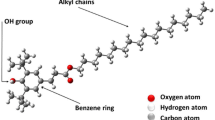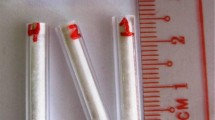Abstract
l-Glutamic acid (L-GA) pellets (3.8 mm × 4 mm) and powder dosimeters were studied in the dose range of 0.1–150 kGy using the electron paramagnetic resonance (EPR) technique. The EPR spectra of irradiated L-GA pellets showed an EPR signal with eight lines, and the intensity of the signal increased with an increase of absorbed dose. The results obtained in terms of the energy-absorption coefficients suggest a similar performance of the L-GA pellets as compared to alanine pellets. The value of the temperature coefficient for the L-GA pellets during irradiation was around − 0.08%/°C which is lower than that reported for alanine dosimeter, 0.14%/°C. The influence of humidity on the pellet response was found to be negligible; i.e., the increase in response was only about 2% for a relative humidity of up to 94%. The response of L-GA powder reached stability 4 h after irradiation and continued to be stable until 47 days after irradiation. In contrast, the response of the L-GA pellet dosimeter reached stability 22 h after irradiation and continued to be stable until 8 days after irradiation. For routine applications, the L-GA pellet dosimeter should be analyzed during the stable period after irradiation, to minimize the uncertainties in dose assessment. The overall two-sigma uncertainties in absorbed dose estimation were 5.1% and 3.9% for the dose ranges of 0.1–15 kGy and 15–150 kGy, respectively. It is concluded that L-GA pellets represent a promising dosimeter material for quantification of radiation doses in food irradiation, medical sterilization and polymer modification.












[data taken from Hubbell and Seltzer (2004)]
Similar content being viewed by others
References
Abdel-fattah AA, Ezz El-Din H, Abdel-rehim F (2004) New alanine/EPR dosimeter using EVA copolymer/paraffin as A binder for high-dose radiation dosimetry: performance characterization. Int J Polym Mater Polym Biomater 53:927–939
Abdel-Fattah AA, Abdel-Rehim F, Soliman YS (2012) A new label dosimetry system based on pentacosa-diynoic acid monomer for low dose applications. Radiat Phys Chem 81:70–76
Alkhorayef M, Mansour A, Sulieman A et al (2017) Evaluation of dose uncertainty in radiation processing using EPR spectroscopy and butylated hydroxytoluene rods as dosimetry system. Radiat Phys Chem 141:50–56
Bakan MH, Aydin M, Osmanolu E (2010) Investigation of 60Co γ-irradiated l-(−) malic acid, N-methyl-dl-valine and l-glutamic acid γ-ethyl ester by electron paramagnetic resonance technique. J Mol Struct 983:200–202
Beshir WB, Abdel-Fattah AA, Abdel-Rehim F, Hassan HM (2012) EPR dosimetric properties of radiation—formed radicals in arginine monohydrochloride. J Photochem Photobiol B Biol 116:1–6
Bracco P, Costa L, Luda MP, Billingham N (2018) A review of experimental studies of the role of free-radicals in polyethylene oxidation. Polym Degrad Stab 155:67–83
Chen F, Graeff CFO, Baffa O (2007) Response of l-alanine and 2-methylalanine minidosimeters for K-band (24 GHz) EPR dosimetry. Nucl Instrum Methods Phys Res Sect B Beam Interact Mater At 264:277–281
Ciesielski B, Wielopolski L (1994) The effects of dose and radiation quality on the shape and power saturation of the EPR signal in alanine. Radiat Res 140:105–111
Desrosiers MF, Peters M, Puhl JM (2009) A study of the alanine dosimeter irradiation temperature coefficient from 25 to 80 °C. Radiat Phys Chem 78:465–467. https://doi.org/10.1016/j.radphyschem.2009.03.026
Eid S, Ebraheem S, Sobhy A (2014) ESR dosimetric properties of sodium glutamate. Egypt J Rad Sci Appl 27:151–164
Gallo S, Iacoviello G, Panzeca S, Veronese I, Bartolotta A, Dondi D, Gueli AM, Loi G, Longo A, Mones E, Marrale M (2017) Characterization of phenolic pellets for ESR dosimetry in photon beam radiotherapy. Radiat Environ Biophys 56:471–480
Gancheva V, Sagstuen E, Yordanov ND (2006) Study on the EPR/dosimetric properties of some substituted alanines. Radiat Phys Chem 75:329–335
Greenspan L (1977) Humidity fixed points of binary saturated aqueous solutions. J Res Natl Bur Stand Sect A Phys Chem 81:89–96
Guidelli EJ, Lima IS, Baffa O (2018) Monosodium glutamate for accidental, retrospective, and medical dosimetry using electron spin resonance. Radiat Environ Biophys 57:349–356
Hansen JW, Olsen KJ (1989) Predicting decay in free-radical concentration in l-α-alanine following high-LET radiation exposures. Int J Radiat Appl Instrum Part A Appl Radiat Isot 40:10–12
Hassan GM, Ikeya M (2000) Metal ion-organic compound for high sensitive ESR dosimetry. Appl Radiat Isot 52:1247–1254
Hubbell JH, Seltzer SM (2004) Tables of X-ray mass attenuation coefficients and mass energy-absorption coefficients (version 1.4). http://physics.nist.gov/xaamdi. Accessed 2019
ISO/ASTM 51707 (2015) Guide for estimating uncertainties in dosimetry for radiation processing. In: Annual book of ASTM standards. ASTM International, West Conshohocken, PA
ISO/ASTM51607 (2013) Practice for use of the alanine-EPR dosimetry system. In: Annual book of ASTM standards. ASTM International, West Conshohocken, PA
Khoury HJ, da Silva EJ, Mehta K, de Barros VS, Asfora VK, Guzzo PL, Parker AG (2015) Alanine-EPR as a transfer standard dosimetry system for low energy X radiation. Radiat Phys Chem 116:147–150
Kornacka EM, Przybytniak G, Świeszkowski W (2013) The influence of crystallinity on radiation stability of UHMWPE. Radiat Phys Chem 84:151–156
Lelie S, Hole EO, Duchateau M, Schroeyers W, Schreurs S, Verellen D (2013) The investigation of lithium formate hydrate, sodium dithionate and N-methyl taurine as clinical EPR dosimeters. Radiat Meas 59:218–224
Lin WC, Mcdowell CA, Rowlands JR (1961) Electron spin resonance of X-ray irradiated single crystals of glutamic acid hydrochloride. J Chem Phys 35:757–758
Lund A, Olsson S, Bonora M, Lund E, Gustafsson H (2002) New materials for ESR dosimetry. Spectrochim Acta Part A Mol Biomol Spectrosc 58:1301–1311
Lund E, Gustafsson H, Danilczuk M, Sastry MD, Lund A, Vestad TA, Malinen E, Hole EO, Sagstuen E (2005) Formates and dithionates: sensitive EPR-dosimeter materials for radiation therapy. Appl Radiat Isot 62:317–324
Maghraby A, Mansour A, Tarek E (2012) Taurine for EPR dosimetry. Radiat Environ Biophys 51:255–261
Nagy V, Puhl JM, Desrosiers MF (2000) Advancements in accuracy of the alanine dosimetry system. Part 2. The influence of the irradiation temperature. Radiat Phys Chem 57:1–9
Nette HP, Onori S, Fattibene P, Regulla D, Wieser A (1993) Coordinated research efforts for establishing an in international radiotherapy dose intercomparison service based on the alanine/ESR system. Appl Radiat Isot 44:7–11
Ogawa M, Ishigure K, Oshima K (1980) ESR study of irradiated single crystals of amino acids—I. Glutamic acid and glutamic acid hydrochloride. Radiat Phys Chem 16:281–287
Olsson SK, Lund E, Lund A (2000) Development of ammonium tartrate as an ESR dosimeter material for clinical purposes. Appl Radiat Isot 52:1235–1241
Olsson S, Sagstuen E, Bonora M, Lund A (2002) EPR dosimetric properties of 2-methylalanine: EPR, ENDOR and FT-EPR investigations. Radiat Res 157:113–121
Osmanoǧlu Ş, Aydin M, Osmanoǧlu YE, Dicle IY, Başkan MH (2011) Structure and behaviour of the free radicals generated in gamma irradiated amino acid and iminodiacetic acid derivatives. Spectrochim Acta Part A Mol Biomol Spectrosc 78:1611–1614
Piroonpan T, Katemake P, Panritdam E, Pasanphan W (2017) Alternative chitosan-based EPR dosimeter applicable for a relatively wide range of gamma radiation doses. Radiat Phys Chem 141:57–65
Prydz S, Henriksen T (1961) Radiation induced free radicals in alanine and some related amino acids. Electron spin resonance studies. Acta Chem Scand 15:791–802
Regulla DF, Deffner U (1982) Dosimetry by ESR spectroscopy of alanine. Int J Appl Radiat Isot 33:1101–1114
Rushdi MAH, Abdel-Fattah AA, Sherif MM, Soliman SS, Mansour A (2014) Strontium sulfate as an EPR dosimeter for radiation technology application. Radiat Phys Chem 106:130–135
Rushdi MAH, Abdel-Fattah AA, Soliman YS (2017) Radiation-induced defects in strontium carbonate rod for EPR dosimetry applications. Radiat Phys Chem 131:1–6
Sagstuen E, Hole EO (2009) Radiation produced radicals. In: Brustolon M, Giamello E (eds) Electron paramagnetic resonance, a practitioner’s toolkit. Wiley, Hoboken, pp 325–382
Sharpe P, Miller A (2009) Guidelines for the calibration of routine dosimetry systems for use in radiation processing. NPL report CIRM 29
Sleptchonok OF, Nagy V, Desrosiers MF (2000) Advancements in accuracy of the alanine dosimetry system. Part 1. The effects of environmental humidity. Radiat Phys Chem 57:115–133
Soliman YS, Abdel-Fattah AA (2012) Magnesium lactate mixed with EVA polymer/paraffin as an EPR dosimeter for radiation processing application. Radiat Phys Chem 81:1910–1916
Soliman YS, Ali LI, Moustafa H, Tadros SM (2014) EPR dosimetric properties of 2-methylalanine pellet for radiation processing application. Radiat Phys Chem 102:11–15
Wexler A, Hasegawa S (1954) Relative humidity-temperature relationships of some saturated salt solutions in the temperature range 0 °C to 50 °C. J Res Natl Bur Stand 53:19–26
Author information
Authors and Affiliations
Corresponding author
Ethics declarations
Conflict of interest
The authors declare that they have no conflict of interest.
Additional information
Publisher's Note
Springer Nature remains neutral with regard to jurisdictional claims in published maps and institutional affiliations.
Rights and permissions
About this article
Cite this article
Beshir, W.B., Soliman, Y.S., Abdel-Fattah, A.A. et al. A new EPR dosimeter based on glutamic acid for radiation processing application. Radiat Environ Biophys 58, 501–511 (2019). https://doi.org/10.1007/s00411-019-00808-y
Received:
Accepted:
Published:
Issue Date:
DOI: https://doi.org/10.1007/s00411-019-00808-y




